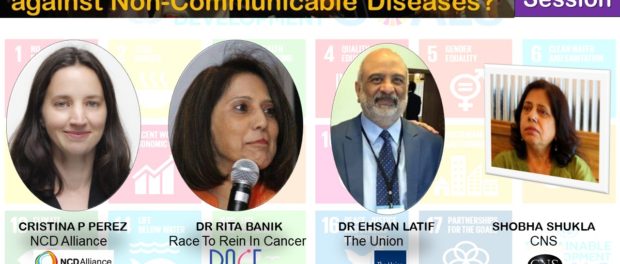Communicate with each other to beat the non-communicable diseases
Get our headlines on WHATSAPP: 1) Save +1 (869) 665-9125 to your contact list. 2) Send a WhatsApp message to that number so we can add you 3) Send your news, photos/videos to times.caribbean@gmail.com

Shobha Shukla, Citizen News Service – CNS
According to the Global Status Report on NCDs, India shares more than two-thirds of the total death burden due to non-communicable diseases (NCDs) in the southeast Asia region of the World Health Organization. Around 5.87 million (58.7 lakh) deaths, which is 60% of all deaths in India, are attributed to NCDs.
Cardiovascular diseases (coronary heart disease, stroke, and hypertension) contribute to 45% of all NCD deaths followed by chronic respiratory disease (22%), cancers (12%) and diabetes (3%), said Professor (Dr) Rishi Sethi, Department of Cardiology, King George’s Medical University (KGMU).
The WHO acknowledges that the factors contributing to NCDs include tobacco use, unhealthy diet, physical inactivity, harmful use of alcohol and air pollution – the first four of these being behavioural and hence modifiable.
Promise is not enough: Urgent actions needed to #beatNCDs
One of the targets of the 3rd Sustainable Development Goal (SDG-3) envisages to reduce premature deaths due to NCDs by 33% by the year 2030 (as compared to 2015). Even though governments around the world have committed to achieve the SDGs, actual actions on the ground must match the governments’ political commitment, to win the race against NCDs. They need to have the capacity, skills and infrastructure to prioritise and execute a cost-effective action plan for reaching these goals.
As Dr Ehsan Latif, Senior Advisor (NCDs) at the International Union Against Tuberculosis and Lung Disease (The Union) rightly points out, “Even as we have to provide for continuous ongoing care for people who already have heart disease, diabetes, hypertension, cancer, a more important bet is to prevent the next generation from suffering from these diseases. It would make sense for governments to focus on preventive care as well, by tackling the preventable risk factors.”
India’s National Health Policy 2017, (NHP 2017) aims to reduce the number of premature deaths from NCDs by 25% by the year 2025. Unfortunately there seems to be a disconnect between policy and action. While the NHP 2017 stresses upon balanced, healthy diets and regular exercises, conditions on the ground do not support this. More than 66% of the Indian adolescents aged 11-17 years are physically inactive as per WHO standards. But, other than rhetoric, very little is being done to save them from the onslaught of killer NCDs.
Roads are far from being safe or user friendly for pedestrians and cyclists. There are hardly any footpaths worth the name, traffic violations are the norm, making the streets unsafe for those who dare to walk. Recently there was a news that, perhaps out of political vendetta, the present government of an Indian state would demolish bicycle tracks, which had been built by the previous government for safe movement of cyclists with a view to conserve the environment and encourage cycling as a sustainable means of transport.
Then again, in the absence of any worthwhile public transport system, school children commute by cars, private buses, tempos, scooters, etc that pick them up from their doorsteps and drop them at the school gates. Most schools do not have playgrounds and the games period is generally viewed as a free period or taken up by other teachers for the so-called more important subjects. So where does physical activity fit in?
This is in total contrast of most Western countries where majority of the people, including some parliamentarians, use a robust public transport system to commute; roads have walkable footpaths for pedestrians and designated lanes for cyclists. Thus the city structure encourages and provides a conducive space for physical activity.
Add to the lack of physical exercise, the ever increasing consumption of fast food and sugary drinks, and you have a lethal concoction. For Dr Ehsan Latif, the big ‘elephant in the room’ are the industries behind the major risk factors for NCDs – unhealthy foods, sugary beverages, tobacco, alcohol.
While the western countries have woken to this reality, we are still groping in the dark. According to a newspaper report , the GST (Goods and Services Tax) imposed in India from 1st July 2017, would make gorging on junk food cheaper as many of them would cost less thereafter. However, there will be a slight price increase for aerated and sugary beverages. Levy of 28% GST (highest slab) on tobacco products too have not resulted in significant change in selling price.
Dr Latif said to Citizen News Service (CNS) that the national action plan for NCDs for the next 5-10 years must include increasing taxes on unhealthy food, sugary drinks, alcohol and tobacco not only to raise resources but also to decrease their consumption. According to him, “There is every need to target the advertising campaigns of the unhealthy food and beverage industries, and raise taxes on all these unhealthy products which are cheaply available there in the market and fuelling NCDs.”
Cristina Parsons Perez, Capacity Development director, NCD Alliance, firmly, and rightly, believes that unless there is high level political commitment; unless there are government structures and mechanisms that allow various ministries (like those of education, urban development, transport, trade and finance) to engage with health issues and work in tandem; and unless people living with NCDs are brought centre-stage of the discussions around NCDs, realising the 2025 and 2030 targets around NCDs would well remain a dream. The cost of inaction would indeed be heavy.
Shobha Shukla, Citizen News Service – CNS
(Shobha Shukla is the Managing Editor of CNS (Citizen News Service) and has written extensively on health and gender justice over decades. Follow her on Twitter @Shobha1Shukla or visit CNS: www.citizen-news.org)
Leave a comment
You must be logged in to post a comment.